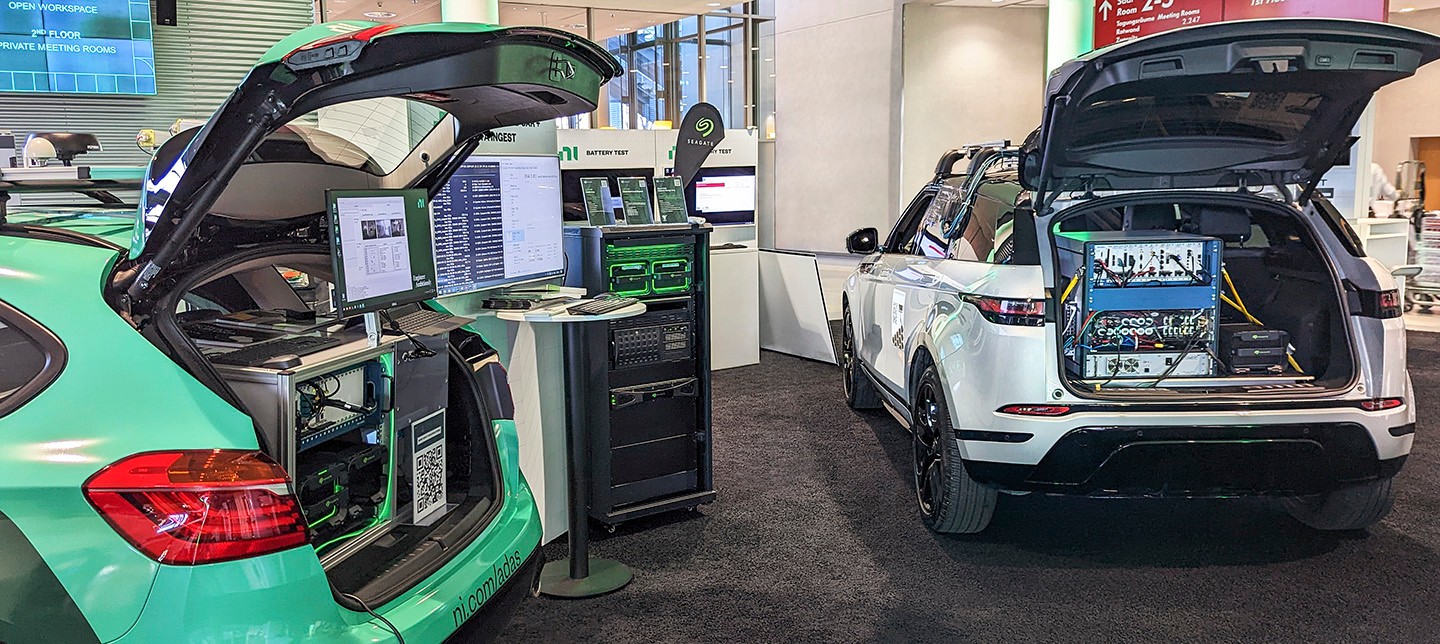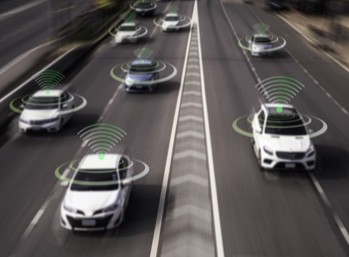
Safe like a Robot. Drives like a Human.
TREND INSIGHT
TRANSPORTATION | 8 MINUTE READ
Jaguar Land Rover is using NI hardware & software to perfect its automated driving verification & validation workflow to usher in the future of mobility.
AUTHOR: Daniel Riedelbauch, Chief Solutions Marketing Manager, ADAS & AD Test, NI
Relax in your vehicle, while traveling long or short distances, totally avoiding any sort of congestion and preventing any collisions that lead to harm for traffic participant. Autonomous mobility will bring us this amazing future. To make this a reality, you have to start from the very foundation and build purpose into your brand DNA. Jaguar Land Rover did this and continues to do so, by driving their reimagined strategy to fulfill their vison—creating the world’s most desirable luxury vehicles, the best driving experience, and of course, new digital services.
Figure 1: Comparison of a typical Level 2 assisted driving feature versus a highly automated driving function.
“My passion is in assisted and automated driving, to make roads a safer place to be. There are still too many accidents happening. With assisted and automated driving, we can help to reduce those. To make the car behave like a robot but drive like a human—this is, I think, one of the best engineering tasks that you can think of,” says Joerg Schlinkheider, Chief Engineer for Assisted and Automated Driving (AAD) at Jaguar Land Rover. But to get there, we still have to maneuver around a couple of roadblocks. So, let’s drive right into this and explore how the fine engineers at Jaguar Land Rover are engaging in partnerships, setting up their test strategy, and utilizing data to bring forward the promise of highly automated driving together.
Data and Test Challenge
Many challenges exist to putting vehicles out on the road, as they need to be safer while using higher levels of automated driving. For example, a level 2 feature like automated emergency braking (AEB) can be found in many cars today. One of the key performance indicators for an AEB function is false activation. One of the main test methods is based on replaying a finite set of recorded scenarios in an open loop. The main parameter to consider is the change of distance between the ego vehicle and the target in front over time. This parameter makes the amount of data still reasonable, and the test complexity remains manageable.
But as we move toward higher levels of automation, safety features become more complex. Functions are now based on neural networks, so they do not only require thorough validation—they must be trained first. Therefore, an extra set of training artifacts must be created and then exercised by the neural network before the actual testing can happen. In addition, features for highly automated driving interact much more with the ego vehicle. They not only take control of the brakes, like in our AEB example, but they also plan and steer the trajectory of the ego vehicle. Hence, a tight closed-loop validation approach becomes a necessity and the number of scenarios for testing converges towards infinity. As the amount of both simulated and recorded data at Jaguar Land Rover is massive already, their clear focus is on maximizing the utilization of those datasets to further optimize time, effort, and cost of test.
Data and Test Strategy
It’s all about data. Data and data analytics are the new fuel for automotive products that Jaguar Land Rover develops and manufactures. The end-to-end relationships with other interfaces and systems around the vehicles are increasing and call for an end-to-end validation strategy. Their structured, layered, and data-driven approach unlocks product potential and performance. A lot of data is pushed into the cloud, where the teams at Jaguar Land Rover run data analytics to understand in which situations or scenarios an interface has passed or failed. They undergo a rigorous systems engineering and validation design process; both the left and the right side of the V-model must be absolutely synchronized. Every requirement must be traceable to achieve the necessary robustness of their products, which are then released to customers.
Obviously, Jaguar Land Rover has a strong focus on the early stages, using the shift left or front-loading strategy for design, development, and test. Close collaboration between the validation engineers, the systems engineers, and software architects is essential. The well-known principle of system engineering also applies to agile development. If you don’t specify and get your requirements right in the beginning, it will be very costly in the end. To avoid this penalty, every requirement must be traceable, as validation engineers should influence the model-based system design in the early stages. All the data derived from test cars, test rigs, or test assets is pushed into the cloud to make data-driven decisions. Essentially, this process ensures that robust safety features accompany new modern luxury.
Figure 2: Jaguar Land Rover's Verification and Validation Test Strategy
NI is a company we work very closely with. We see a lot of really good engineering that fits to the way we want to design our products and to the mindset that we have in our validation teams.
NI is a company we work very closely with. We see a lot of really good engineering that fits to the way we want to design our products and to the mindset that we have in our validation teams.
Jaguar Land Rover and NI are implementing this data and test strategy together. Multiple, different testing methodologies like lab-based testing using software-in-the-loop (SIL), hardware-in-the-loop (HIL), and open-road testing must be orchestrated in perfect harmony. Using the same common NI hardware and software platform to generate data from both systems under test and from reference systems has been a key to the success of Jaguar Land Rover. Using XIL test environments like SIL, HIL, and vehicle-in-the-loop (VIL) make their verification and validation (V&V) more robust and efficient. This leads to better quality overall—quality in V&V and quality of the end product. The openness of the NI toolchain allows Jaguar Land Rover to adjust the toolsets to their processes and not the opposite. Furthermore, Jaguar Land Rover is partnering with NI on joint future developments like AI-based scene detection. This capability will allow them to identify interesting and relevant scenarios, so they can quickly bring them into their sophisticated validation process. Converting these highly relevant datasets to virtual scenarios to close the loop will further enable them to test with scenarios driven by real-world situations, leading to lower cost of data and higher data efficiency.
Partnerships
The automotive industry has seen a paradigm shift in terms of future product creation and delivery. The classic Tier 1 to OEM relationship already feels like a fond memory of the past. New technology and infrastructure needs are both required to either be the next innovation or to fuel the next innovation. Jaguar Land Rover believes in strong partnerships, and therefore has joined forces with NVIDIA—a powerhouse in software, AI, and System on Chip (SoC) development. Both engineering teams are working closely together on a white-box software collaboration to create the next generation of driver assistance systems and autonomous driving.
As mentioned previously, Jaguar Land Rover is closely collaborating with NI to put their test strategy into action. One of the big advantages of this partnership for Jaguar Land Rover is that NI also works with many other companies in areas and industries such as aviation and defense; considerable knowledge and experience can transfer to automotive from these other domains. Jaguar Land Rover believes they can learn from NI and its ecosystem to achieve their robust, structured approach to validation. For example, an important introduction that NI made for Jaguar Land Rover is the connection to Seagate Technology. Logging and storing data are critical for Jaguar Land Rover’s ground-truth data systems. Seagate has expanded their LYVE portfolio into rugged, enterprise-grade, high-performance storage combined with consumer ease of use, data logistics, data operations, and other services. This specialized area of expertise is something that only a global player and subject matter expert like Seagate can address; therefore, they are a perfect match for Jaguar Land Rover within NI’s data logger solutions.
Nobody Is Perfect, but a Team Can Be…
Jaguar Land Rover is on a continuous improvement journey and to achieve their reimagine vision with confidence, the goal is to get the data coming in and, of course, pass all their test cases. This bold goal can only be achieved by utilizing the power of great teams—and Jaguar Land Rover is forming one of the best global teams right now. They have been transforming their business to agile, tearing down silos and hierarchy. Engineers are now empowered to lead and make decisions from wherever they are in the world. They are creating the new products for an even safer future of mobility.
“At Jaguar Land Rover we are reimagining our brands through the power of our people, our partnerships, our new data-driven products and of course through cutting edge design. And that means we need to recruit the best people and we need to partner with the best,” says Schlinkheider.



